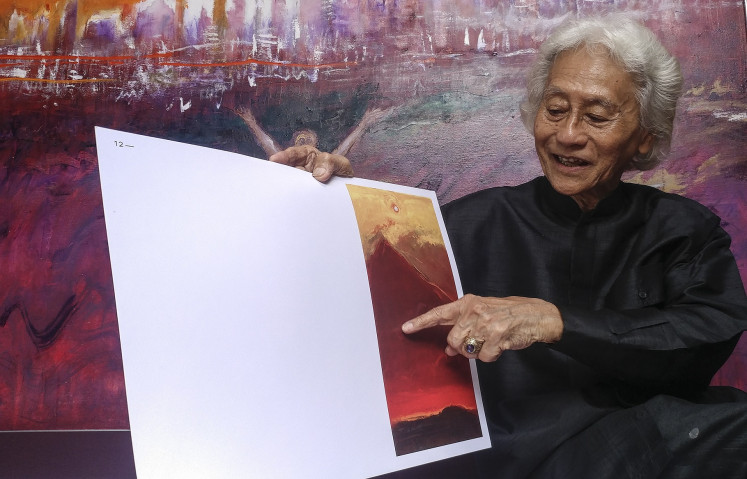A celebration of Srihadi’s eleven windus of life

At 88 years old, Indonesian maestro painter Srihadi Soedarsono is still productive and disciplined in his creative process.
Srihadi, who once worked as a painter reporter during the Indonesian independence revolution era, will hold his 21st solo exhibition entitled Man & Universe from March 11 to April 10 at the National Gallery in Jakarta.
For the display, Srihadi is presenting his latest 37 works created over the past three years. A total of 44 paintings from his private collection will be shown.
“Some are old ones like Bandung Jelita Satu [Beautiful Bandung One], which can be compared with Bandung Jelita Dua [Beautiful Bandung Two] to find the change in Bandung’s landscape from the past to the present,” said Srihadi at his home on Jan. 29.
Originally, only 36 new paintings were going to be displayed, but Srihadi had already finished another one entitled Jakarta Megapolitan – Patung Pembebasan Banjir (Megapolitan Jakarta – Flood Liberation Statue).
Red, purple and dark orange dominate this 128-by-205 centimeter painting, with the West Irian Liberation Monument in Banteng Square, Jakarta, in the foreground and submerged buildings lower than the statue. White paint in the background depicts solid high-rise construction.
“The Jakarta floods [in early 2020] were a big event,” he said.
On top of the canvas is a maroon annular solar eclipse. Srihadi relies on observations and imagination in creating his work.
“Painting is like recording,” said the painter, who was a member of the Young Indonesian Artists under S. Sudjojono in from 1946 to 1948.
The same process has been applied to his other art in the show, such as Papua – The Golden River Belongs to its People, a work that he finished in 2017 as a contemplation of an event in 1970, when he was flown in a helicopter over Sorong, Papua, to work on a job for state oil company PT Pertamina.
Srihadi marks the horizon as an important element to present the natural boundary with sunrise and sunset in his Papua – The Energy of Golden Rivers, measuring 105 by 600 centimeters.
“The rivers look golden from the sky when flying in the morning and afternoon,” noted Srihadi.
The recipient of the Bintang Gerilya RI (Indonesian Guerrilla Star) also interprets the existence of humans, cultures and the universe in his creations. One of them is Horizon – The Golden Harvest, depicting Hindus maintaining their paddy fields through an irrigation system called subak without ignoring their daily religious rituals.
There are no details of the people and paddy being harvested, but his impressions are reflected.
“A landscape isn’t a mere ‘mooi indie’ [beautiful picture] to attract tourists. There’s more profound beauty. It’s part of a culture, so it isn’t just an expression,” he said.
The lines brushed on the canvas along with their colors, according to Srihadi, result from sensitized feelings. They symbolize a spiritual dialogue between artistic ideas and the energy he feels while painting. Srihadi showed his works themed Borobudur Temple and Volcanoes, with such energy emanating from them.
Srihadi releases his emotions through the colors he paints while moving from one canvas to another in his studio to match his prevalent feelings. Technically, as the oil paint hasn’t dried yet, the husband of Siti Farida Nawawi tries to get new hues.
“Every color can represent a certain atmosphere. The point is to enhance [the works], so I’m moving from rice fields to mountains,” he added.
Exhibition curator A. Rikrik Kusmara said this time Srihadi would like to convey several messages. He added that from 2016 to 2020, Indonesia had entered different sociopolitical contexts of greater intensity involving issues of identity, welfare and religion.
“Srihadi’s creations offer metaphors and symbols of complexity. Though not so explicit, the issue of Papua is composed through his Golden River Belongs to Its People, which is very close to Papua becoming a political commodity,” said the fine art lecturer at the Bandung Institute of Technology (ITB).
Srihadi’s latest landscape paintings are also very interesting and challenging to study.
“Behind the subtle aesthetic series, something is worth observing and exploring in each of the works as well as the whole batch as an interrelated configuration,” Rikrik suggested.
The painter encourages contemplation about human existence and its relation with nature. Despite Srihadi’s dominant mountain, land and sea images, he never forgets the presence of humans and their cultures.
“There’s dynamism. There’s an offer to pause to look ahead, which is a cultural moment,” said Rikrik, adding that the maestro had had a long career since the war of independence.
The solo exhibition will also see the launch of Srihadi Soedarsono: Manusia dan Alam Semesta (Srihadi Soedarsono: Man and the Universe), written by cultural observer Jean Couteau. Srihadi’s previous retrospective solo displays were in 2012 and 2016. In 2016 he presented 300 drawings and water color paintings produced over his 70-year career.
How can Srihadi be so productive in his creative process? “I lead a regular life. I maintain discipline to make constant progress,” said Srihadi, who exercises with his trainer at home twice a week.
source Jakarta Post


